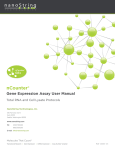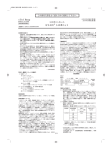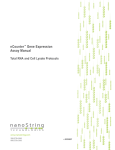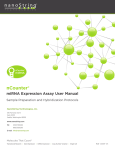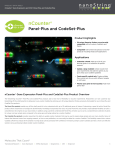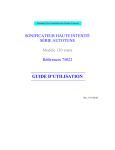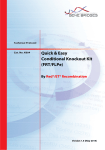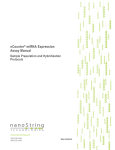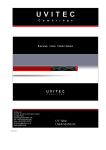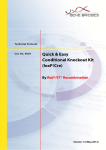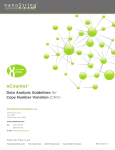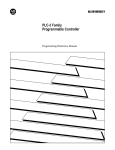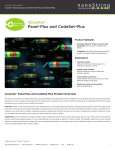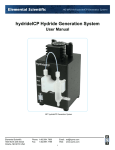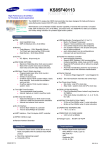Download nCounter® DNA Assay - NanoString Technologies
Transcript
nCounter® DNA Assay User Manual NanoString Technologies, Inc. 530 Fairview Ave N Suite 2000 Seattle, Washington 98109 www.nanostring.com Tel: 206.378.6266 888.358.6266 E-mail: [email protected] Molecules That Count® Translational Research Gene Expression miRNA Expression Epigenomics Copy Number Variation MAN-C0024-02 nCounter® DNA Assay USER MANUAL FOR RESEARCH USE ONLY. Not for use in diagnostic procedures. Intellectual Property Rights This nCounter® Analysis System manual and its contents are the property of NanoString Technologies, Inc. (“NanoString”), and is intended solely for the use of NanoString customers, for the purpose of operating the nCounter Analysis System. The nCounter Analysis System (including both its software and hardware components) and this User Guide and any other documentation provided to you by NanoString in connection therewith, are subject to patents, copyright, trade secret rights and other intellectual property rights owned by, or licensed to, NanoString. No part of the software or hardware, may be reproduced, transmitted, transcribed, stored in a retrieval system, or translated into other languages without the prior written consent of NanoString. Limited License Subject to the terms and conditions of the nCounter Analysis System contained in the product quotation, NanoString grants you a limited, nonexclusive, non-transferable, non-sublicensable, research use only license to use the proprietary nCounter Analysis System only in accordance with the manual and other written instructions provided by NanoString. Except as expressly set forth in the terms and conditions, no right or license, whether express, implied or statutory, is granted by NanoString under any intellectual property right owned by, or licensed to, NanoString by virtue of the supply of the proprietary nCounter Analysis System. Without limiting the foregoing, no right or license, whether express, implied or statutory, is granted by NanoString, to use the nCounter Analysis System with any third party product not supplied or licensed to you by NanoString, or recommended for use by NanoString in a manual or other written instruction provided by NanoString. Trademarks NanoString Technologies, NanoString, nCounter and Molecules That Count are registered trademarks or trademarks of NanoString Technologies, Inc., in the United States and/or other countries. All other trademarks and/or service marks not owned by NanoString that appear in this manual are the property of their respective owners. Copyright © 2008–2013 NanoString Technologies, Inc. All rights reserved. 2 NanoString™ Technologies USER MANUAL Preface............................................................................................................................................................................................... 4 Conventions Used............................................................................................................................................................. 4 Note Types.......................................................................................................................................................................... 4 Fonts............................................................................................................................................................................. 4 Procedures.......................................................................................................................................................................... 4 Contact Information.......................................................................................................................................................... 4 CHAPTER 1: Introduction...................................................................................................................................................... 6–9 Overview ............................................................................................................................................................................ 6 NanoString Technology.................................................................................................................................................. 6 Core Principles and Procedures..................................................................................................................... 6 General Considerations for DNA Assays.................................................................................................................... 7 Fragmentation.................................................................................................................................................... 7 Denaturation....................................................................................................................................................... 8 DNA Input Amount........................................................................................................................................... 8 DNA Quality........................................................................................................................................................ 8 nCounter DNA Assays Overview.................................................................................................................................. 9 nCounter Copy Number Assays..................................................................................................................... 9 nCounter ChIP-String Assays......................................................................................................................... 9 CHAPTER 2: nCounter DNA Assay Protocols ........................................................................................................... 11–17 Overview ............................................................................................................................................................................11 Fragmentation of Genomic DNA via Alul Restriction Digestion (12 Reactions).............................................11 Covaris-AFA Fragmentation (recommended for DNA from FFPE samples)...................................................13 Special Consideration for ChIP-String Assays....................................................................................................... 14 Preparing Hybridization Reactions............................................................................................................................15 Instruments and Reagents Required for DNA Assays............................................................................17 APPENDIX ......................................................................................................................................................................................18 Molecules That Count® Translational Research Gene Expression miRNA Expression Epigenomics Copy Number Variation 3 nCounter® DNA Assay USER MANUAL The following conventions are used throughout this manual and are described below for your reference: Special font formatting is used in this manual. Such formatting conventions are used in specific instances as described below: Numbered procedures appear frequently providing step-by-step instruction for accomplishing a task. Typically, a numbered step provides direction for a specific action and may be followed by the expected response. Additional information may be presented in the form of a specific note type, bullets, screen capture or other image important to facilitate clarity and understanding. NanoString Technologies, Inc. 530 Fairview Ave N Suite 2000 Seattle, Washington 98109 USA Tel: 206.378.6266 888.358.NANO (6266) Fax: 206.378.6288 E-mail: [email protected] 4 NanoString™ Technologies USER MANUAL This page intentionally left blank. Molecules That Count® Translational Research Gene Expression miRNA Expression Epigenomics Copy Number Variation 5 nCounter® DNA Assay 1 Introduction This manual covers the procedures for setting up hybridizations for all nCounter® DNA Assays. These include the nCounter Custom® CNV Assay, CNV panel products (Karyotype and Cancer CN), and ChIP-String Assays. The nCounter® DNA Assays are based on NanoString’s core technology for measuring abundance of nucleic acids via digital detection of color-coded barcodes. The nCounter DNA assays are designed to provide sensitive, reproducible and highly-multiplexed methods for detecting genomic variations for up to 800 sequences (e.g., genomic loci) per reaction. They are compatible with a variety of DNA samples types including, genomic DNA, DNA from FFPE samples, enriched DNA, and whole genome amplified DNA. This manual describes in detail the methods for setting up the nCounter® DNA hybridization assays. Please see the nCounter® Prep Station User Manual, nCounter® Digital Analyzer User Manual, nSolver Analysis Software User Manual, and product-specific nCounter® Data Analysis Guidelines for instructions on post-hybridization processing and data analysis. NanoString’s nCounter technology is based on direct detection of target molecules using color-coded molecular barcodes, providing a digital count of the number of target molecules. The probe pair consists of a Reporter Probe, which carries the signal on its 5’ end, and a Capture Probe which carries a biotin on the 3’ end. The color codes carry six positions and each position can be one of four colors, thus allowing for a large diversity of codes that can be mixed together in a single reaction tube for direct hybridization to target and yet still be individually resolved and identified during data collection. FIGURE 1.1: Capture and Reporter Probes (left) and, Probe pair bound to a ssDNA molecule (right). CAPTURE PROBE REPORTER PROBE TARGET-PROBE COMPLEX TARGET Probe pairs are placed into a reaction in excess to target DNA to ensure that each target finds a probe pair. 6 NanoString® Technologies NanoString™ Technologies USER MANUAL FIGURE 1.2: Purification process. excess probes removed After hybridization, excess probes are washed away using a two-step magnetic bead-based purification on the nCounter Prep Station. Purification and binding of the hybridized complexes is carried out automatically on the nCounter Prep Station. Magnetic beads derivatized with short nucleic acid sequences that are complementary to the Capture Probe and the Reporter Probes are used sequentially. First, the hybridization mixture is allowed to bind to the magnetic beads by the Capture Probe. Wash steps are performed to remove excess Reporter Probes as well as DNA fragments that are not hybridized. After washing, the Capture Probes and Target/Probe complexes are eluted off of the beads and are hybridized to magnetic beads complementary to the Reporter Probe. Wash steps are performed and excess Capture Probes are washed away. Finally, the purified Target-Probe complexes are eluted off and are immobilized in the cartridge for data collection. Data collection is carried out in the nCounter Digital Analyzer. Digital images are processed and the barcode counts are tabulated in a comma separated value (CSV) format. The nCounter DNA Assays include the Copy Number Assays, ChIP-String Assays, or assays for DNA isolated from other experimental conditions (e.g., MeDIP, NGS libraries, etc.). Much like NanoString’s RNA-based assays, the nCounter DNA assays are compatible with a wide variety of DNA sample types. However, additional handling steps are generally required for processing DNA on the nCounter System. Below are some important things to consider before using an nCounter assay with a DNA sample. If you are considering using samples that are not addressed in this manual, please contact our customer support representatives at [email protected]. Genomic DNA is typically larger in size (> 20kb) than the average RNA (~1.5kB). Thus, regardless of sample type the DNA must be fragmented prior to analysis on nCounter. In the case of immunoprecipitated material (ChIP-String Assays), the DNA has typically been fragmented during the IP process and additional fragmentation is not required. The DNA Prep kit is supplied with all nCounter CNV assays. This kit contains the reagents necessary for fragmentation of genomic DNA via the restriction endonuclease, Alu I. Digestion of human genomic DNA with Alu1 results in an average of 500bp fragments. Optimal target fragments for hybridization (~100–750 bases) are selected in probe design process. Other fragmentation methods are also compatible with the nCounter DNA assays. For the most accurate results in FFPE samples, we recommend fragmentation via Covaris AFA™ technology. The optimal target size range is 200-300 bases. It may also be possible to use chemical, standard sonication or mechanical fragmentation methods if fragment length is controlled adequately. For best results, all samples (including reference) should have similar fragmentation profiles. Please contact NanoString support at [email protected]. Molecules That Count® Translational Research Gene Expression miRNA Expression Epigenomics Copy Number Variation 7 nCounter® DNA Assay USER MANUAL DNA is typically double-stranded in its biological conformation whereas RNA is single-stranded. Therefore, DNA must be denatured prior to hybridization using the nCounter System. NOTE: Denaturation temp must be 95°C. Incomplete denaturation may result in decreased accuracy. The recommended mass of input genomic DNA for nCounter DNA assays is 300ng, three times greater than the mass of RNA input required for the nCounter GX assays. This is due to the fact that most non-repetitive genomic DNA sequences are present on average at 2 copies per cell in normal diploid samples. In contrast, the amount of a given mRNA sequence can range from one to many thousands of copies per cell. Most genomic loci are present at 2 copies in normal diploid human cells. If sample amount is not limiting, increasing input DNA amount to 600ng may provide better resolution for single copy changes (i.e., 1-2, or 3-4 copies) and increase accuracy for highly degraded FFPE samples. Similarly, we recommend using the maximal setting on the Digital Analyzer when scanning samples run with an nCounter DNA assay. This will maximize the signal thereby reducing uncertainty in the measurements. For DNA that has been enriched (via immunoprecipitation, NGS exome capture, target enrichment, etc.) the input requirements are typically lower than those required for standard genomic DNA. For these sample types, recommended starting input amounts are 5–50ng (depending on the level of enrichment), however, input amounts may need to be optimized for some experimental conditions. The maximum sample input volume for an nCounter DNA hybridization is 5–10μL. Thus, sample DNA concentration must be high enough to provide adequate mass of DNA in a 5–10μL sample. DNA used in the nCounter assay MUST be free of contaminating RNA for accurate copy number analysis. NanoString strongly recommends that you RNAse treat your DNA preparations using DNAse-Free RNAse as described by the extraction kit manufacturer. RNA contamination may negatively impact the quality of the data in two ways: 1. Although probes are selected to non-exonic sequences, unprocessed RNA may result in artificially increased signal and copy number determinations. 2. RNA may result in over estimation of DNA concentration when measured by UV absorbance, leading to lower than recommended DNA input amounts and lower counts. For pure genomic DNA preparations, we recommend A260/280 ratios between 1.7 and 1.9, and A260/230 ratios between 1.3 and 2.0. Fluorescence-based assays, (e.g., QuBit, Life Technologies) using dyes specific for DNA, may provide the most accurate concentration measurements if RNA contamination is suspected. DNA extracted from FFPE is typically degraded due to the fixation and storage process. The nCounter FFPE protocol and analysis guidelines have been optimized to produce the most accurate results from FFPE samples. In order to generate accurate results, the average size of the extracted DNA from FFPE tissues must be greater than 1kb (prior to fragmentation). See Appendix Section IV for an example of size variability of FFPE samples. 8 NanoString™ Technologies USER MANUAL NanoString’s DNA Assays can be divided into two categories: Copy Number Assays and ChIP-String Assays. nCounter Copy Number assays enable precise quantification of copy number and include the following products: • The nCounter Custom CNV Assay measures copy number variation for up to 800 loci in a single reaction. Probes are designed to target customer-defined regions in the human genome. • The nCounter Karyotype Assay is a fixed-content panel designed to invariant regions (i.e., non-CNV) covering all of an organisms chromosomes and is intended for detection of large chromosomal abnormalities (e.g., aneuploidy). • The nCounter Cancer CN Assay is a fixed-content panel designed to 86 genes commonly amplified or deleted in cancer cells. To increase performance of analysis of FFPE samples of varying quality, 3 probes have been designed for each gene. All nCounter Copy Number Assays utilize the same protocol (as described below) and require fragmentation of DNA for accurate analysis. Chromatin Immunoprecipitation is a technique used to study protein-DNA interactions. This method is widely used to determine which specific proteins or histone modifications are associated with certain genomic regions or features, such as promoters, enhancers and insulators or whether a gene is in an active, repressed, or poised state. Chromatin Immunoprecipitation generally involves cross-linking of proteins to DNA, fragmentation of the cross-linked DNA via sonication and immunoprecipitation with an antibody to a specific protein or histone modification (Figure 1.2). The antibody-protein-DNA complexes are then purified, the proteins are removed and DNA is isolated. The result of a successful ChIP preparation is a relatively pure and highly enriched DNA fragment population. The enriched DNA fragments can then be interrogated using NanoString ChIP-String assay via the protocol below. NanoString does not offer reagents or support for performing ChIP protocols. Users are expected to identify and optimize a ChIP protocol based on their specific reagents and research needs. Once samples are prepared via a user-defined ChIP method, Nanostring’s ChIP-String Assay allows the user to study up to 800 candidate genomic regions that correspond to the binding sites of the protein or locations of histone modifications of interest. The sensitivity of the nCounter ChIP-String Assay allows for direct dection of enriched ChIP’d DNA and thus requires as little as 5–10ng of DNA input. The process of ChIP generally requires fragmentation of DNA and additional fragmentation is not required to perform the read-out via the ChIP-String assay. Molecules That Count® Translational Research Gene Expression miRNA Expression Epigenomics Copy Number Variation 9 nCounter® DNA Assay USER MANUAL FIGURE 1.2: Graphical illustration of ChIP-String protocol. Crosslink DNA and Proteins and Isolate Chromatin User-defined Protocol Sonicate or Digest Chromatin Immunoprecipitate Reverse Crosslinking, Purify DNA, Amplification (optional) nCounter Protocol NanoString® nCounter 10 NanoStringnCounter nCounter NanoString ® USER MANUAL 2 nCounter DNA Assay Protocol All nCounter DNA assays require that the genomic DNA be fragmented prior to hybridization. Starting Material for ChIP-String is typically fragmented during the immunoprecipitation process and does not required additional fragmentation (skip to page 14 to learn about special considerations for ChIP-String assays). Two methods of fragmentation are acceptable, Alu1 restriction enzyme digestion or Covaris AFA™based fragmentation. When using intact (i.e., non-degraded) genomic DNA from cell lines, blood, or fresh or frozen tissue, we recommend using Alu1-based fragmentation. For degraded genomic DNA, either from FFPE samples or other sources, we recommend the Covaris-based fragmentation method, although Alu1 can also be used. If your samples have previously been fragmented by other methods or do not meet the optimal fragmentation profiles described below, please contact your Field Application Scientist for guidance. IMPORTANT: If your samples have been fragmented as part of experimental set-up (for example, ChIP or NGS library prep), the fragmentation step may be omitted. However, for accurate copy number results, it is critical that all samples have similar fragmentation profiles (Appendix Figures I and II show ideal fragmentation profiles for Alu I digested and sonicated DNA). Please contact customer support for additional information ([email protected]). IMPORTANT: If setting up a master mix, add reagents for 13 reactions to account for dead volume. When using a master mix, a minimum digest volume of 5μL (300ng DNA) is recommended. The entire 5μL digest can be added to the hybridization in Step 5 on page 7 of the Hybridization Set Up section. If your DNA concentration is < 29ng/μL, we recommend that the sample be ethanol precipitated with a carrier such as linear acrylamide (see page 12, step 7 for protocol example). We do not recommend vacuum drying the sample as this method concentrates salts and other components that may inhibit the AluI digestion reaction. Molecules That Count® Translational Research Gene Expression miRNA Expression Epigenomics Copy Number Variation 11 nCounter® DNA Assay USER MANUAL 1. Set up a restriction enzyme fragmentation as follows in a 0.2mL – 0.5mL PCR tube*. Recommended DNA input is 600ng in 7μL of sample (minimum of 200ng). The minimum concentration of Genomic DNA should be 29ng/μL prior to addition to the fragmentation reaction. The non-sample components can also be set up in a master mix (see note above). 7μL containing DNA 600ng in RNase free water*, Tris pH 8.0 or similar 1μL 10X AluI Fragmentation Buffer (supplied with kit) 1μL 10X CNV DNA Prep Control† (supplied with kit) 1μL AluI Fragmentation Enzyme (5U/μL, supplied with kit) 10μL total volume 2. Mix and spin briefly to bring contents to the bottom of the tubes. 3. Incubate Alu I digestion reaction at 37°C for at least 2 hours in a heat block or thermocycler with heated lid turned on. If proceeding directly to hybridization, samples should be denatured at 95°C for 5 minutes (Step 2 on page 7 of the Hybridization Set Up section) upon completion of restriction digestion. 4. Optional: If desired, check the profile of AluI digested DNA on 1% agarose gel or Bioanalyzer DNA chip. See Appendix 1 for an example of a typical size distribution for human genomic DNA digested with AluI. 5. When reaction is complete, proceed to hybridization protocol. Use 5-10μL (300ng) of the Alu I digested sample in the hybridization. Any remaining Alu I digested samples can be stored at -20°C for future use. * RNA is a component of the Reporter CodeSet. To reduce the risk of RNase contamination during the restriction digest set-up, use RNase-free water, tips and gloves when performing the CNV Assay Protocol. † If desired, the DNA Prep Control reagent can be separated into 14μL aliquots for storage. 12 NanoString™ Technologies USER MANUAL 1. Start with approximately three 10 micron slices of FFPE tissue*. 2. Isolate DNA from FFPE tissue using an accepted protocol (an example of a commonly used kit is the QIAamp DNA FFPE Tissue kit from Qiagen®). Please ensure the genomic DNA is free of contaminating RNA. 3. Check concentration to confirm DNA yield using NanoDrop™ (1.5μL) or fluorescent-based dye detection method. 4. Dilute 500ng to 1ug of DNA in 130μL 10mM Tris. 5. Fragment the DNA with a Covaris-AFA instrument. Use the settings defined by the manufacturer to produce 200bp fragments (actual settings may vary depending on the model of the instrument). 6. After fragmentation is complete, run 1μL, approximately 4ng, of sample on an Agilent® 2100 Bioanalyzer using a High Sensitivity DNA Kit to check and make sure you achieved desired degree of fragmentation. For successful sonications, there should be a single peak centered between 200 and 300 bases with an average mass ranging from 250-450 base (see Appendix Section II). Presence of multiple peaks or peak heights greater than 300 indicated less than optimal sonication. See Appendix Section III. 7. EtOH precipitate the fragmented DNA using linear acrylamide as the carrier1 by adding the following to the 130μL sonicated sample: 2 μL linear acrylamide (Ambion 5mg/ml) 14.7μL of 3M sodium acetate pH 5.5 367μL of EtOH 8. a. Put at -20° C for 2 hours or longer b. Spin down at 4°C at max speed (16,000 X g) for 30 minutes in benchtop centrifuge c. Remove EtOH d. Add 250μL 70% EtOH e. Spin down at 4°C at max speed for 5 minutes f. Remove EtOH being careful not to disturb pellet Resuspend precipitated DNA in 11.5μL of 10mM Tris. * The yield of RNA from a given FFPE sample is highly variable. In general, we have found that three 10μm slices will yield a sufficient amount of DNA for most samples. 1 Gaillard, C. and Staves, F. (1990) N.A. Research, Vol 18, N02, 378. Note: other non-nucleic acid-based carriers such as, glycogen can also be used. ‡ Accuracy increases with increasing amounts of DNA input. Molecules That Count® Translational Research Gene Expression miRNA Expression Epigenomics Copy Number Variation 13 nCounter® DNA Assay USER MANUAL Additional fragmentation beyond that performed as part of the ChIP protocol is not required to use the nCounter ChIP-String assay as a readout method. However, there are other factors that should be considered prior to proceeding with ChIP-String assay set-up: • A minimum of 5ng – 10ng (1ng/μL – 2ng/μL) of unamplified ChIP’d DNA input is recommended. The input amount is highly dependent on the level of enrichment of the target molecules (see below). • Direct detection (without amplification) of target molecules from ChIP assay requires that the DNA is significantly enriched. For example, 1ng of human genomic DNA has approximately 330 copies of any non-repetitive sequence (i.e., 2 copies per genome). Thus 5 – 10ng of unenriched genomic DNA sample would contain approximately 1600 – 3300 molecules which is roughly equal to the limit of detection for the nCounter system. In order to confidently measure the sequences associated with any given ChIP experiment an enrichment of at least 10 fold over un-enriched genomic DNA (or 16,000 – 33,000 molecules in 5 – 10ng) is recommended. nCounter signal increases linearly with increasing amount of input DNA sample. If sample is not limiting, increasing input amount will result in higher signal and higher confidence in the measurements. • The amount of enrichment is highly dependent on the ChIP protocol, the affinity of the antibody used, and whether the protein of interest is directly bound to genomic DNA or associated with other proteins that are bound to DNA. If a new procedure or ChIP reagents are being used a positive control sample is highly recommended. • If DNA from ChIP is amplified via whole-genome amplification, then 100ng input is recommended. 14 nCounter® DNA Assay USER MANUAL IMPORTANT: Prior to proceeding with hybridization set-up, make sure that you have a thermocycler programmed to perform steps 5 and 7. IMPORTANT: If a qualified thermocycler is not available, a 65°C hybridization oven may be used. (The use of a thermocycler is recommended if possible. Assay results may be more variable in a hybridization oven due to less stringent temperature control.) To use a hybridization oven, place a large beaker full of water in the oven to ensure a humid environment. Do not place the samples in the water beaker; evaporative loss causes the water temperature to be below the air temperature in the oven. Place the samples in a dry rack in the middle of the oven shelf, or tape the strip tubes to a rotator in the center of the oven. Make sure that the strip tubes and/or rack do not touch the sides or bottom of the oven. Failure to follow these instructions may result in uneven hybridization temperatures which can compromise the results. IMPORTANT: General Probe Handling Warning - During setup of your assay, do not vortex or pipet vigorously to mix as it may shear the Reporter Probes. Mixing should be done by flicking or inverting the tubes. Also, if you use a microfuge to spin down tubes, do not spin any faster than 1,000 rpm for more than 30 seconds and do not “pulse” it to spin because that will cause the centrifuge to go to maximum speed and you may spin your CodeSet out of solution. IMPORTANT: After it has thawed, inspect the tube of Reporter CodeSet to make sure no colored precipitate is present. If you see a colored precipitate, heat the entire tube to 75°C for 10 minutes and cool at room temperature before using. IMPORTANT: It is advisable to use a fresh tip for each pipetting step to accurately pipet the correct volume. The CodeSet has components that can start to wick up into the tip and not dispense the correct amount if you use the same tip to dispense master mix into all of the hybridization tubes. The final hybridization reaction is 30μL and contains the following components: 10μL Reporter CodeSet, 10μL hybridization buffer, 5μL of sample DNA, and 5μL Capture ProbeSet. The order of addition of components is important, please follow the protocol exactly. 15 1. Remove aliquots of both Reporter CodeSet and Capture ProbeSet reagent from the freezer and thaw on benchtop at room temperature. Invert or flick tube several times to mix well and spin down reagent. 2. Create a master mix containing 130μL of the Reporter CodeSet and 130μL of hybridization buffer. Add hybridization buffer directly to Reporter CodeSet tube. Do not add the Capture ProbeSet to the master mix. Invert to mix and spin down master mix. 3. Label a provided 12 tube strip and cut it in half so it will fit in a picofuge. 4. Add 20μL of master mix to each of the 12 tubes. NanoString™ Technologies USER MANUAL IMPORTANT: Denaturation of DNA sample is critical for optimal assay performance. 5. Denature samples at 95°C for 5 minutes. 6. Immediately place on ice for 2 minutes to minimize DNA renaturation. 7. Pre-heat thermocycler to 65°C with heated lid turned on and “forever” time setting. Do not set the thermocycler to ramp down to 4°C at the end of the run. 8. Briefly spin down sample tubes in picofuge. 9. Add 5-10μL of sample to the hybridization tube. 10. Add 5μL of Capture ProbeSet to each. 11. Cap tubes and mix the reagents by flicking with your finger to ensure complete mixing. 12. Briefly spin down in picofuge at < 1000g and immediately place the strip tube in the 65°C thermocycler. Minimizing the time between the addition of the Capture ProbeSet and the placement of the reaction at 65°C will increase the sensitivity of your assay. 13. Incubate hybridization assays for at least 16 hours. Hybridizations should be left at 65°C until ready for processing. Maximum hybridization time should not exceed 30 hours. 14. Remove from the thermocycler and proceed immediately to post-hybridization processing with the nCounter Prep Station. Do not store hybridizations at 4°C. Molecules That Count® Translational Research Gene Expression miRNA Expression Epigenomics Copy Number Variation 16 nCounter® DNA Assay USER MANUAL TABLE 2.1: Instruments required for CNV assay protocol. Instrument Manufacturer Part Number NanoDrop ND-1000 NanoDrop Technologies N/A Pipette for 0.5 – 10 μL Rainin L-10 Pipette for 2 – 20 μL Rainin L-20 Pipette for 20 – 200 μL Rainin L200 Tube-strip MiniFuge VWR 93000-196 DNA engine thermocycler or hybridization oven* MJ Research / BioRad PTC-200G† PTC-1148† PTC-0220G† PTC-0221G† PTC-0240G† nCounter Prep Station NanoString Technologies NCT-PREP-200 nCounter Digital Analyzer NanoString Technologies NCT-DIGA-200 USB memory drive NanoString Technologies N/A Optional: Covaris AFA Instrument (various models) Covaris, Inc. various * nCounter system performance data was generated on model PCT-200 DNA engines. Other instruments may produce non-standard results when used with the nCounter assay. †Any one of these instruments will meet the requirements of the nCounter Assay. TABLE 2.2: Reagents required for DNA assay protocol. Material Manufacturer Part Number nCounter CodeSet* NanoString Technologies CNV-P1CS-nnn nCounter Master Kit NanoString Technologies NAA-AKIT-048 nCounter DNA Prep Kit* NanoString Technologies N/A Sample DNA N/A N/A * Be sure to order the appropriate nCounter CodeSet for the correct DNA assay type. The nCounter CNV, Karyotype CodeSets are NOT interchangeable. 17 NanoString™ Technologies USER MANUAL Agilent Bioanalyzer High-Sensitivity DNA assay profile of 20ng human genomic DNA digested with AluI enzyme for 2 hours at 37ºC. Agilent Bioanalyzer High-Sensitivity DNA assay profile of 20ng human genomic DNA sonicated by Covaris instrument using manufacturer’s recommended settings for 200bp peak. Incomplete sonication. A Bioanalyzer trace of 4ng of FFPE DNA fragmented with Covaris AFA technology. While the majority of the DNA is of the correct size (~ 200 bp) the presence of a high molecular weight peak (100-1500 bp) indicates that the fragmentation was not 100% complete. Analysis of genomic DNA size from FFPE tissues. DNA was extracted from three 10um slices of from 11 FFPE tissues using the RNeasy FFPE kit (Qiagen). To assess DNA size, 150ng of extracted RNA was run on a 0.8% agarose gel. Hyperladder 1 was used as a marker. Samples 3, 6 and 7 have average sizes below 1kb and should be considered “lower quality.” Lane M 1 2 3 4 5 6 7 8 9 10 11 M 1kb Sample Type Recommended Assay Input Recommended Concentration QC Method Genomic DNA (un-enriched) 300 – 600ng > 30ng/μL Agarose gel, confirm complete digestion with nCounter restriction digest controls Target enriched NGS library or DNA prepared by ChIP 5 – 50ng 2 – 10ng/μL BioAnalyzer Molecules That Count® Translational Research Gene Expression miRNA Expression Epigenomics Copy Number Variation 18 USER MANUAL nCounter® DNA Assay NanoString Technologies, Inc. CONTACT US 530 Fairview Ave N Suite 2000 Seattle, Washington 98109 [email protected] United States:[email protected] Tel: (888) 358-6266 Europe:[email protected] Fax: (206) 378-6288 Japan:[email protected] www.nanostring.com Other Regions:[email protected] SALES CONTACTS © 2013 NanoString Technologies, Inc. All rights reserved. NanoString®, NanoString Technologies®, nCounter®, and Molecules That Count® are registered trademarks of NanoString Technologies, Inc., (“NanoString”) in the United States and/or other countries. All other trademarks and or service marks not owned by NanoString that appear in this document are the property of their respective owners. The manufacture, use and or sale of NanoString product(s) may be subject to one or more patents or pending patent applications owned by NanoString or licensed to NanoString from Life Technologies Corporation and other third parties. FOR RESEARCH USE ONLY. Not for use in diagnostic procedures. MAN-C0024-02



















